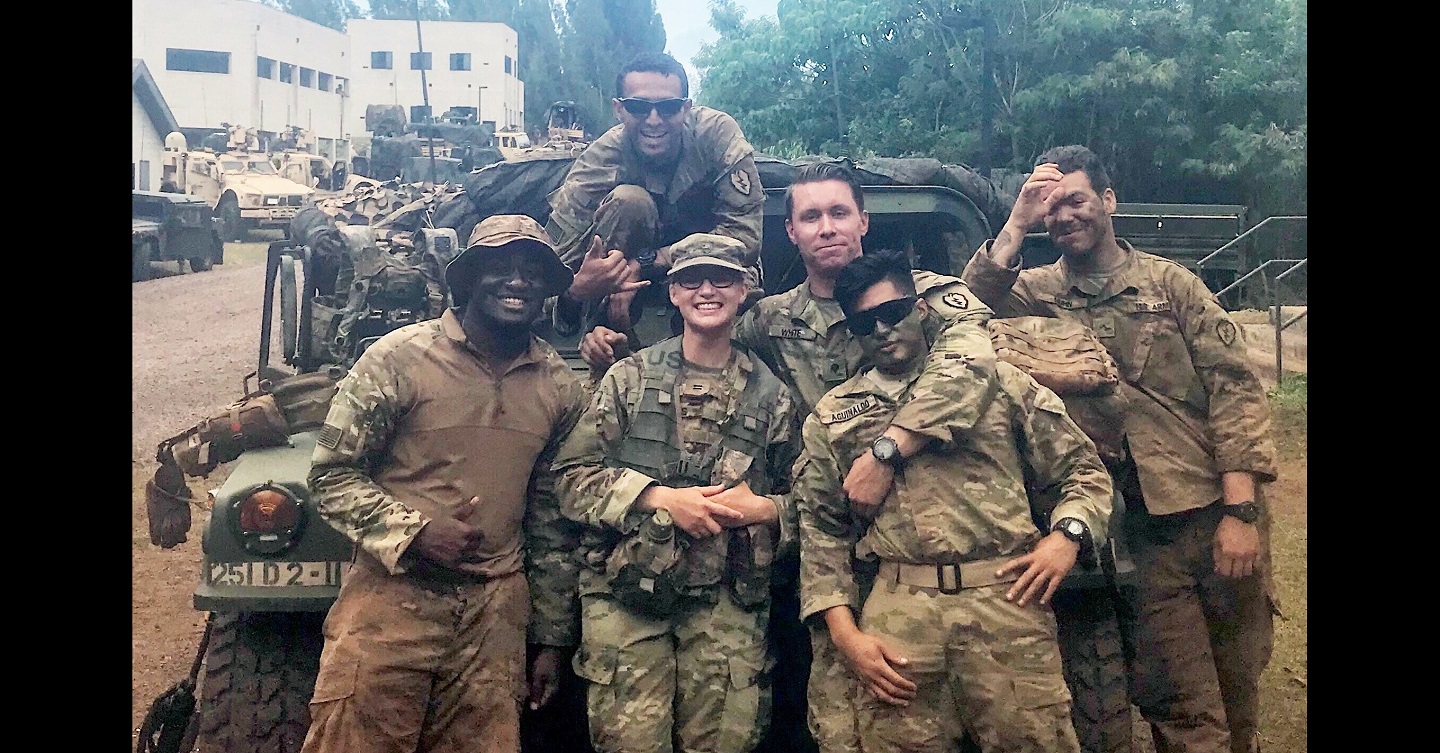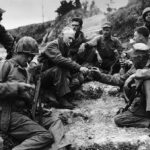
It’s time for the last installment of the AY22 Eisenhower Series. Brian Dudley and Kevin Payne join podcast editor Ron Granieri in the studio to share their thoughts on diversity, equity and inclusion (DEI) in the U.S. Army. In keeping with the Federal government and DoD the Army is continually revising its DEI policies “with the aim of maintaining a vibrant workforce that represents the wide-ranging backgrounds of the American people.” Brian and Kevin describe how their personal and professional experiences and studies have influenced their thoughts on DEI.
You want a force in which any American citizen who can meet the criteria for doing the job feels welcome in the force.
Podcast: Download
Subscribe: Apple Podcasts | Spotify | Amazon Music | Android | Pandora | iHeartRadio | Blubrry | Podchaser | Podcast Index | TuneIn | Deezer | Youtube Music | RSS | Subscribe to A Better Peace: The War Room Podcast
Brian Dudley is a Lieutenant Colonel in the Arizona Army National Guard. He has degrees in Exercise Science and Leadership in Disaster Management. He started his career as an enlisted Soldier, commissioned in 2003 and has experience in Field Artillery, Explosive Ordnance Disposal, Recruiting, Logistics and WMD’s. His background also includes civilian experience with the Arizona Department of Corrections. LTC Dudley is married, has two children, and uses free time to dabble in car restoration, fitness training and fishing of all types. He is a graduate of the AY22 Resident Course at the U.S. Army War College.
Kevin Payne is a Colonel and a Military Police Officer with over 25 years of active duty service in the U.S. Army. His experiences include command at Camp Bucca Iraq and the United States Disciplinary Barracks with key developmental positions at Fort Hood, Texas and staff positions in the pentagon and at the United States army military police school. He has deployed on multiple occasions to Iraq and Afghanistan and in his next assignment he will take command of the 15th MP Brigade and he will be the U.S. Disciplinary Barracks Commandant at Fort Leavenworth, Kansas. He is a graduate of the AY22 Resident Course at the U.S. Army War College.
Ron Granieri is an Associate Professor of History at the U.S. Army War College and the Editor of A BETTER PEACE.
The views expressed in this presentation are those of the speakers and do not necessarily reflect those of the U.S. Army War College, U.S. Army, or Department of Defense.
Photo Description: West Point Class of 2020 Cadet Elizabeth Cross, center, spent Cadet Troop Leader Training with the 25th Infantry Division in Hawaii this past summer. Cross’ time with Coldsteel Company was the first time a woman had been embedded as a member of the company.
Photo Credit: Photo Courtesy of Elizabeth Cross
Other releases in the “Eisenhower Series”:
- THE REAL FOREVER WAR: THE WAR ON DRUGS
(EISENHOWER SERIES) - GREAT POWER COMPETITION: ALLIANCES IN INDOPACOM
(EISENHOWER SERIES) - WHAT DOES IT LOOK LIKE TO FIGHT LIKE A GIRL?
(EISENHOWER SERIES) - PRESERVING DOMESTIC SECURITY
(EISENHOWER SERIES) - OBSERVATIONS FROM NATO’S NORTHERN FRONT REVISITED
(EISENHOWER SERIES) - CANDID CONVERSATIONS ON DIVERSITY
(EISENHOWER SERIES) - THE EISENHOWER SERIES COLLEGE PROGRAM: 50 YEARS OF OUTREACH
(BACK TO SCHOOL) - TO WHAT END? INTERESTS AND VALUES IN AFGHANISTAN
(EISENHOWER SERIES) - RECONSIDERING GREAT POWER COMPETITION
(EISENHOWER SERIES) - STRATEGY FROM THE INSIDE OUT
(EISENHOWER SERIES)





As an Army brat and an Army Vietnam veteran (as my father was), I’ve heard “statistics” for years that tend to always put the American soldier and climate in which we fought in a bad light, especially by historians who never served at all. Here are another set of statistics.
Myth: Common belief is that a disproportionate number of blacks were killed in the Vietnam War.
Fact: 86% of the men who died in Vietnam were Caucasians, 12.5% were black, 1.2% were other races. Sociologists Charles C. Moskos and John Sibley Butler, in their recently published book “All That We Can Be,” said they analyzed the claim that blacks were used like cannon fodder during Vietnam “and can report definitely that this charge is untrue. Black fatalities amounted to 12 percent of all Americans killed in Southeast Asia, a figure proportional to the number of blacks in the U.S. population at the time and slightly lower than the proportion of blacks in the Army at the close of the war.”
In looking at such things as DEI today, should we do this in consideration of the changed strategic context discussed below?
” … Thus, affirmative action, understood and applied in this manner, has fundamentally different goals from the (U.S. Supreme) Court’s Cold War-era project of desegregation. (Back then) Desegregation served the needs of a Nation State that was attempting to be ‘the provider and guarantor of [individual] equality.’ In large part, desegregation was an effort to assimilate minorities into the dominant national groups, thus forging a national people that could meet the external Communist enemy with a united front, and so denying that enemy an opportunity to exploit potentially dangerous rifts within the Nation. Affirmative action, as upheld in (the 2003 case of) ‘Grutter,’ is also thought to serve the Nation’s strategic needs, but in an international environment that is markedly different from the Cold War. No longer does the Court feel a need to foster a national unity that transcends racial consciousness or to further the assimilation of racial minorities. Such strategic needs have passed, together with the passing of the Cold War’s chief external threat. Thus the ‘Grutter’ Court could view the prospect of multiculturalism with equanimity despite the fact that, as (Sir Philip) Bobbitt correctly perceives, multiculturalism makes it ‘increasingly difficult’ for a Nation State ‘to get consensus on public-order problems and the maintenance of rule-based legal action.’ Rather than regarding the rise of multiculturalism as a liability that had the potential to weaken or even fracture the Nation, the Court saw it as an asset to be exploited for all the advantages it could bring American businesses in their international transactions. And again, race-conscious governmental action is viewed through the prism of its usefulness, not its morality.”
(Items in parenthesis above are mine. See the Catholic University of America, Columbus School of Law, paper “Moral Communities or a Market State: The Supreme Court’s Vision of the Police Power in the Age of Globalization,” by Antonio Perez and Robert Delahunty; therein, look about half way down on Page 703.)
Some additional context may be helpful here. In this regard, consider — re: the paper that I reference above — this from Page 643 thereof. Therein, look toward the bottom of the paragraph that begins “We agree with Bobbitt … “:
”
“Proponents of this vision of a globalized economy characterize the United States as ‘a giant corporation locked in a fierce competitive struggle with other nations for economic survival’ so that ‘the central task of the federal government’ is ‘to increase the international competitiveness of the American economy.”
Question:
Should we see DEI — in the U.S. military, in the U.S. Government and in the U.S. business world today — this, as per the strategic environment/as per the strategic requirements discussed above?
A number of reasons are often given for pursuing such things as DEI, such as:
a. The “forming of a national elite that possesses legitimacy in the eyes of all its citizenry.”
b. To “meet the business needs created by competition in today’s increasingly global marketplace.” And:
c. The “forging of a national people that could meet the external … enemy with a united front … so denying that enemy any opportunity to exploit potentially dangerous rifts within the Nation.”
(Looking carefully, I believe that you can find all of these such reasons on Page 702 (bottom) thru 704 of the Catholic University of America paper that I reference in my initial comment above.)
What appears to be missing from these such thoughts, however, is an understanding that:
a. In pursuing such things as DEI,
b. One might not eliminate — but indeed might CREATE and/or EXASPERATE — “dangerous rifts within the Nation;” thus, CREATING a unique and powerful opportunity for an (internal and/or external) enemy to exploit same.
In this regard — and with our internal and external enemy experiences of late — how now do we view the cost/benefit analysis related to such things as DEI presently?
There seems to be a confusion between equality and equity. The latter defines entitlement while equality defines a balanced equilibrium. Example of equity is the transgender swimmer in the all female event which allows for equity, but disregard equality for the rest of the competitors. Equity in the Army ranks will give an unequal and unequivocal view where a selected group have a marked ‘entitlement’ over others. The BLUF is the binary question of can the individual performs its Warrior task without any advantages over others? Use UFC or the Olympics for social equity lab experiments. The military claim to uphold the standards regardless of gender, but always changes the conditions for the standard to be met. Unfortunately the military does not owns the conditions in combat as the opponent always has a vote. I completely support equality and equal opportunity. But is equity a guarantor of equality?
LTC Dudley, at approximately the 24:00 time on this podcast, emphasizes that “the only constant is change.” However, in consideration of:
a. The difficulties that the Soviets/the communists had in advancing and securing enduring change, re: communism, in the Old Cold War of yesterday. And, in consideration of:
b. The difficulties that the U.S./the West has had in advancing and securing enduring change, re: capitalism, globalization and the global economy, in the New/Reverse Cold War of today;
In consideration of these such epic difficulties (and epic failures?), should we not also concede that “resistance to change” — and even “reversal of change” (as well as the ability of leaders to use their “resistance to change”/”reversal of change” positions to gain ENORMOUS power, influence and control) — these, also, are “constants?”
And, if these constant “resistance to change”/”reversal of change” entities do not win outright — as the U.S./the West did in the Old Cold War of yesterday — then they can certain force the pro-change forces to re-think both the scope, and the scale, of their “change” ambitions — as the Islamists, etc., have done re: the U.S./the West’s “achieve revolutionary change abroad” efforts of late — and as Donald Trump, etc., have done re: the U.S./the West’s “achieve revolutionary change at home” efforts of late.
Herein — if not winning outright — by dramatically changing the cost/benefit analysis of the pro-change forces, the “resistance to change”/”reversal of change” forces (those both here at home and there abroad) show that they have equal — or better — “constants” clout?
The U.S. Supreme Court’s overturning of Roe v. Wade today, this would seem to be consistent with my “resistance to change/reversal of change are constants also” argument above.
Thus:
a. Much as the conservatives in the Islamic world have acted decisively — to reject modernity and, for example, force their women to again wear the Burka, stay at home, etc.
b. Likewise now the conservatives in the U.S. have acted decisively in much this same manner?
The overturning of Roe v. Wade, thus, completely destroying the ability of the U.S./the West to continue to advance their (decades old/centuries old?) foreign policy goals — of modernizing the less-modern states and societies of the world?
(Talk about the consequences of overturning Roe !!!!)
Bottom Line: After today, the U.S. can no longer look any other country in the face — and ask them to “change”/to “modernize.”
LTC Dudley, at approximately the 24:00 time on this podcast, emphasizes that “the only constant is change.” However, in consideration of:
a. The difficulties that the Soviets/the communists had in advancing and securing enduring change, re: communism, in the Old Cold War of yesterday. And, in consideration of:
b. The difficulties that the U.S./the West has had in advancing and securing enduring change, re: capitalism, globalization and the global economy, in the New/Reverse Cold War of today;
In consideration of these such epic difficulties (and epic failures?), should we not also concede that “resistance to change” — and even “reversal of change” (as well as the ability of leaders to use their “resistance to change”/”reversal of change” positions to gain ENORMOUS power, influence and control) — these, also, are “constants?”
And, if these constant “resistance to change”/”reversal of change” entities do not win outright — as the U.S./the West did in the Old Cold War of yesterday — then they can certain force the pro-change forces to re-think both the scope, and the scale, of their “change” ambitions — as the Islamists, etc., have done re: the U.S./the West’s “achieve revolutionary change abroad” efforts of late — and as Donald Trump, etc., have done re: the U.S./the West’s “achieve revolutionary change at home” efforts of late.
Herein — if not winning outright — by dramatically changing the cost/benefit analysis of the pro-change forces, the “resistance to change”/”reversal of change” forces (those both here at home and there abroad) show that they have equal — or better — “constants” clout?
At my B.C. says: June 21, 2022 at 4:58 pm comment above, I asked whether we should see DEI — in the U.S. military, in the (other) U.S. Government agencies and in the U.S. business world today — this, from the perspective offered by the quoted item that I provided from the paper “Moral Communities or a Market States … .”
At that quoted item, it was suggested that, post the Old Cold War, the strategic environment had changed:
a. From: A time when Old Cold War DEI was seen by the then-U.S. Supreme Court as “an effort to assimilate minorities into the dominant national groups, thus forging a national people that could meet the external Communist enemy with a united front, and so denying that enemy an opportunity to exploit potentially dangerous rifts within the Nation.”
b. To: A time when early Post-Cold War DEI was seen by the then-U.S. Supreme Court as “an asset to be exploited for all the advantages it could bring American businesses in their international transactions.”
Question: With the U.S. Supreme Court’s reversal of “Roe” the day-before-yesterday, what now should we consider to be the strategic foundation upon which DEI will be based ????? (If, in fact, DEI will even be allowed to continue at all; this, under philosophy of the new U.S. Supreme Court.)
Here may be another way of looking at the question that I ask above, to wit: “what now should we consider to be the strategic foundation upon which DEI will be based?”
In this regard, let’s consider this description of today’s grand contemporary conflict (which has both “here at home” and “there abroad” aspects); this, as noted by Walter Russell Meade below:
“In this new world disorder, the power of identity politics can no longer be denied. Western elites believed that in the twenty-first century, cosmopolitanism and globalism would triumph over atavism and tribal loyalties. They failed to understand the deep roots of identity politics in the human psyche and the necessity for those roots to find political expression in both foreign and domestic policy arenas. And they failed to understand that the very forces of economic and social development that cosmopolitanism and globalization fostered would generate turbulence and eventually resistance, as ‘Gemeinschaft’ (community) fought back against the onrushing ‘Gesellschaft’ (market society), in the classic terms sociologists favored a century ago.”
(See the Mar-Apr 2017 edition of “Foreign Affairs” and, therein, the article by Walter Russell Meade entitled “The Jacksonian Revolt: American Populism and the Liberal Order.”)
Thoughts — based on the specific conflict described by Meade above:
a. If one is on the side of “market society,” then (a) DEI would seem to find its strategic foundation as per the early post-Cold War and, thus, (b) would look much the same as that which I describe at item “b” of my B.C. says: June 26, 2022 at 2:29 pm comment above. However:
b. If one is on the side of “community,” then a strategic foundation for DEI would seem to be — unavailable; this, given that (a) such things as DEI, these appear to be (b) antithetical to “community?”